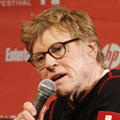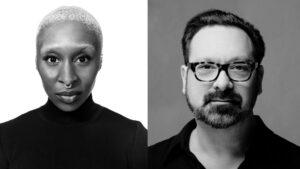Festival Director John Cooper, Executive Director Keri Putnam, and President and Founder Robert Redford. Photo by Calvin Knight.
Claiborne Smith
Thursday’s opening day press conference opened with nothing less than a reference to an American “government in paralysis” – Sundance Institute President and Founder Robert Redford’s allusion to the frustrating inability of the country’s political leaders to compromise with one another. From that sobering reality, however, Redford, Keri Putnam, the Institute’s Executive Director, and John Cooper, the Director of the Sundance Film Festival, pointed out the ways in which artists contribute to a vibrant culture, and what the Institute is doing to be at the forefront of that culture. “The happy thing we’re pretty proud of is that here, for this week, we’re going to see work from artists, who even though their work might be reflective of these hard times, there’s not paralysis here,” Redford said. “There are fresh, new stories I’m happy you’re going to get to see.”
Putnam revealed that there are a healthy 27 feature films in this year’s Festival lineup that were supported by one of the Institute’s Labs – year-round workshops that give filmmakers the ability to work on their stories and grow as artists under the guidance of seasoned creative advisors. She also added that a full 30 percent of artists supported by the Institute are international, stressing that the Institute’s vision is a global one.
Festival attendees at last year’s Festival will remember that there were a number of changes in the way the Festival operated. Meanwhile, Cooper noted that the changes to this year’s Festival “aren’t so easy to spot,” because during his leadership, the Festival has moved closer and closer to how he and the rest of the Festival’s programmers think it should function. You’ll find more music programming at this year’s Festival – nightly sessions at the Music Cafe, added to previous years’ daytime music performances. New Frontier, the Festival program that highlights new ways of storytelling at the intersection of film, art, and new media technologies, has moved to the The Yard (next to The Yard Park & Ride), a more flexible space for the installations, as well as co-exhibiting at Salt Lake Art Center in Salt Lake City. Last year, the Racquet Club Theatre was out of commission; this year, it’s back, though it goes by the moniker MARC (Municipal Athletic and Recreation Center). The Prospector Square Theatre has also been nicely spiffed up.
The changes from last year’s Festival operations are minor, but the Festival and Institute’s commitment to independent storytelling is steadfast. Stressing that he thinks Hollywood and indie film are moving stylistically farther and farther apart from one another, Cooper said that judging from the 2012 Festival lineup, the state of independent film is “very healthy – it’s creative – it’s original.” He added, “I think the stories are as diverse as they can be. I think they’re personal and I think they’re a unique perspective on the world we live in.” Every year, people ask him what the themes of the Festival are, he told the audience. “The truth is, they’re aren’t any,” he acknowledged. “Independent film is the theme, so I hope you seek that too.”




